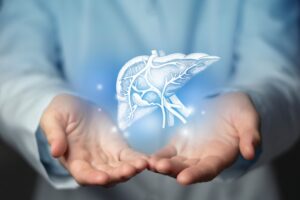Metabolic dysfunction-associated steatotic liver disease (MASLD)
What is metabolic dysfunction-associated steatotic liver disease?
Metabolic dysfunction-associated steatotic liver disease (MASLD) is a condition in which there is an excess of fat in the liver that is not associated with the consumption of alcohol. This is an umbrella condition for metabolic dysfunction-associated steatohepatitis (MASH) and simple fatty liver.
What are the symptoms of metabolic dysfunction-associated steatotic liver disease?
Initial symptoms include fatigue and pain in the upper right abdomen. As the condition progresses, symptoms will turn into an enlarged spleen, swelling in the abdomen, enlarged blood vessels, jaundice, and red palms.
There are also complications that come with MASLD, such as cirrhosis, liver cancer, liver failure, and cardiovascular disease.
What causes metabolic dysfunction-associated steatotic liver disease?
Doctors are unsure of the exact cause of MASLD. However, they have identified risk factors, such as obesity, high blood sugar, insulin resistance, high levels of fat in the blood, type 2 diabetes, high cholesterol, metabolic syndrome, sleep apnea, polycystic ovary syndrome, an underactive thyroid, and an underactive pituitary gland. Older people are more likely to develop this condition as well.
How is metabolic dysfunction-associated steatotic liver disease diagnosed?
It is often difficult to diagnose this condition, as symptoms do not appear until there has been progression. In fact, a diagnosis typically comes in a routine check or tests are done for another issue. Tests used to diagnose this condition include blood tests, CT scans, abdominal ultrasounds, MRIs, transient elastography, and a liver tissue examination.
What are the treatments for metabolic dysfunction-associated steatotic liver disease?
Weight loss and adopting healthy lifestyle practices are the best treatment for MASLD. If cirrhosis has occurred, a liver transplant may be necessary.
There are methods of prevention. Eating a healthy diet, exercising, and maintaining a healthy weight all reduce the risk of MASLD.
Where can I find out more about metabolic dysfunction-associated steatotic liver disease?
MASLD Articles





First Treatment Approved for Nonalcoholic Steatohepatitis Liver Scarring

Updated Study Data Suggests Efruxifermin Benefits Stage 2 or 3 MASH

Investigational Therapy Could be Top of the Line Treatment for MASH





